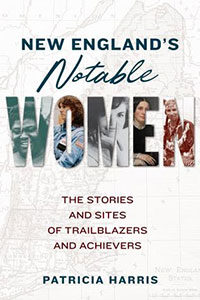 *
*
Patricia Harris met me at my usual spot at the Bloc11 Cafe in Union Square, Somerville, to talk about her latest book New England’s Notable Women: The Stories and Sites of Trailblazers and Achievers.
Harris is a travel-writer (who often shares her byline with her husband the writer, David Lyons) and is a seasoned food and arts reporter. Her articles have often appeared in The Boston Globe and elsewhere.
Harris told me that as a child, “I was always interested in Louisa May Alcott’s novel Little Women, and particularly the character of Jo March. March was always curious and spunky and did not fit into the restrictive conventions of her time for girls. So, it was very interesting to write about these women of the same cloth from all walks of life, and connect a vivid place or home, etc., that resonates with their lives.”

Harris visited sites of 45 notable women. She narrowed down her list to places where her readers could visit. Sometimes she wanted to include a woman, but there was just no relevant site that people could focus on. She said, “I want people to view this as an armchair book, but also as an active one – that people can refer to when they go to the sites such as The Mount or the Alcott Estate, for instance.”
I asked Harris about some of the notable women she covered. We started very locally in Cambridge, with Julia Child. Just over the Somerville line is the Cambridge-based meat and gourmet market Savenor’s. Since Harris couldn’t visit the house Child lived in, (it is not open to the public) she brings the reader to Savenor’s, where the iconic “French Chef” – Julia Child – was a loyal patron, getting the clarified butter, the rarefied cuts of meats and ingredients, for culinary fodder for her creations that wowed TV goers and readers alike. Child was also a denizen of the Harvest, a restaurant in Harvard Square that is still very much in operation today. According to Harris, Child was a very approachable woman, and would often engage in long conversations with pedestrians as she walked the winding streets of Cambridge.
We also touched on Alice Longfellow, of the Longfellow House-Washington’s Headquarters-National Historic Site on Brattle Street in Cambridge. Alice Longfellow, of course, was the daughter of Henry Wordsworth Longfellow, who once referred her to as her “Grave Alice,” in his poem The Children’s Hour.
According to Harris, Alice was instrumental in the renovation, and expansion of the house. She also was a George Washington aficionado and spread the legacy of the man, whose Revolutionary War Headquarters was at the Longfellow House. She also played a major role in the founding of Radcliffe College.
We also discussed Maria Mitchell, the first recognized female astronomer in the United States, who discovered the comet known as “Miss Mitchell’s” comet in1847. She discovered the comet on the top of her house in Nantucket with her little telescope. She later became the first professor at Vassar College and the director of the Vassar College Observatory.
Another of Harris’ favorite women was the enslaved poet Phillis Wheatley. Born in West Africa, she was sold into slavery to Bostonian John Wheatley and his family. This wealthy family educated her and she became a self-taught poet. She later became a household name in the world of poetry. Later on-she left the family’s church and went on be a member of the congregation of the Old South Meeting House in Boston.
Wheatley was an extremely pious woman and was strongly connected to her religion. Some contingents believed that the reserved Wheatley should have spoken up more about white oppression. But Harris feels that as time went on and her faith changed, the poet did speak more strongly about the injustice in society. In the 1770s Wheatley had a collection of 28 poems compiled. However, there was no support to publish it in America, so in 1773 her first collection, Poems on Various Subjects, Religious and Moral, was published in London.
Harris also told me about Kathleen Moore, who was the keeper of the Black Rock Fayerweather Island Lighthouse off the coast of Bridgeport, Connecticut. She held this position for over a half a century (she took over duties at age 12), and was responsible for saving many lives. She reportedly said that at times there were 3 or 4 shipwrecks a night. She was responsible not only to maintain the lighthouse, but to nurse shipwrecked sailors back to life. Unfortunately, she died in obscurity in an unmarked grave.
I asked Harris if she considered herself a feminist and she replied with a wry smile, “I am all about women’s empowerment.” And indeed, these stories and places, with a generous amount of illustrations and photography, are a testament to empowered women.















Reader Comments